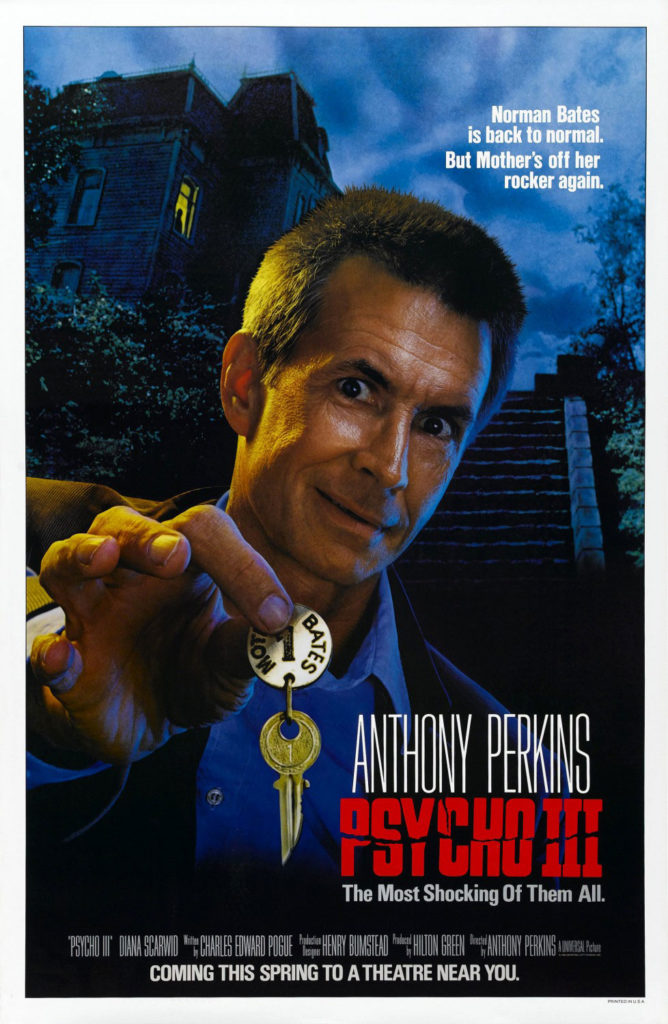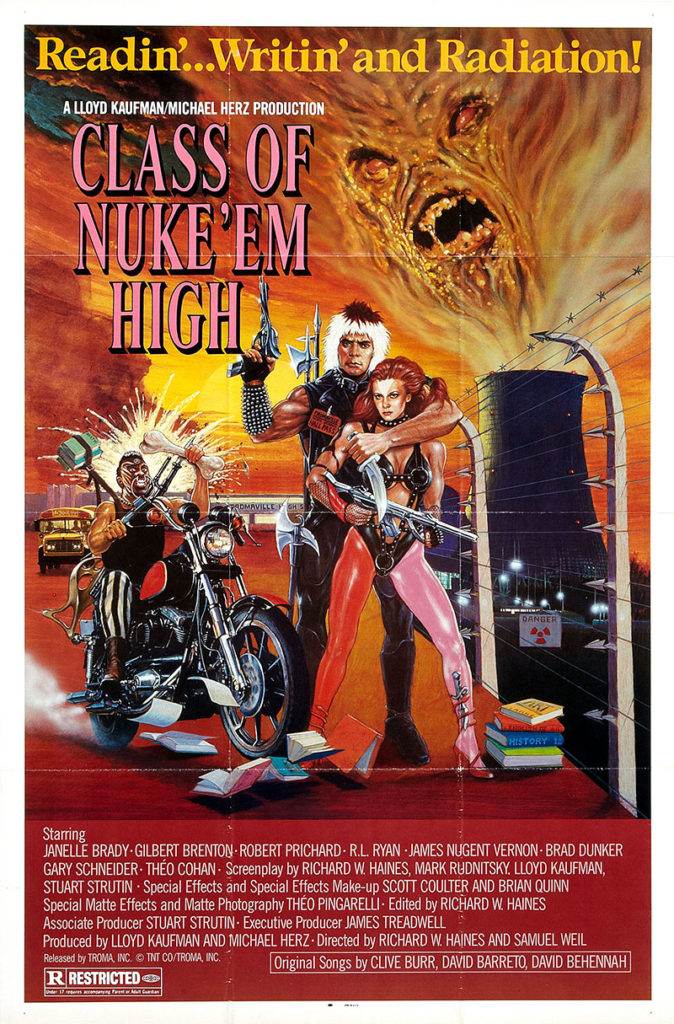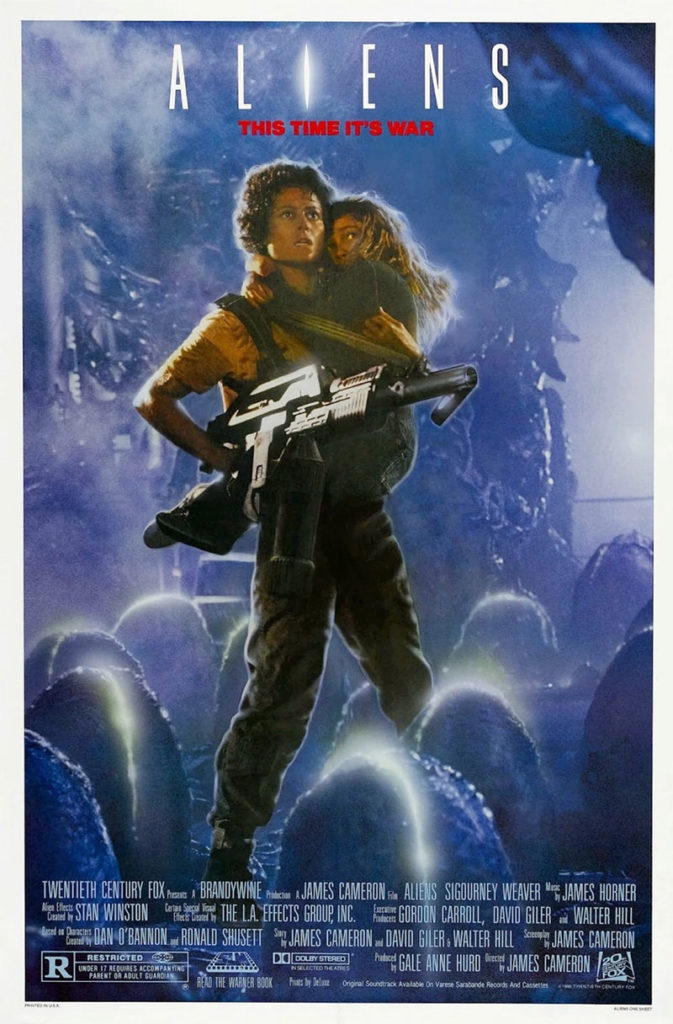This movie is Arnold Schwarzenegger on the cusp. After Conan and The Terminator, people knew who he was, he was a legitimate star, and this earned him more roles. But he was still making movies for Dino De Laurentiis. That man was a producing legend, but not always for the best reasons. For every Blue Velvet or Serpico, there were about five or six Maximum Overdrives. De Laurentiis movies look cheap, like the filmmakers that made them didn’t have the cash they needed, or weren’t competent filmmakers in the first place. Raw Deal was the last De Laurentiis film with Arnold to hit theaters, and Arnold was probably glad about that. Continue reading “Raw Deal”
Tag: 1986 in Film
Critters, or, Power of the Night!
I don’t think I’ve seen this movie since the late 1980s. That’s almost thirty years of depriving myself of big hair, a pack of unstoppable, ravenous fur balls that are more teeth than animal, and Power of the Night, the number one single by Johnny Steele. Oh yeah, this was the decade I grew up in, with all its foibles, bad fashion, and shit music. This was the decade that put Eric Clapton in pastels and convinced teenagers everywhere that synthesizers were an acceptable accouterment to rock music. And my God, Reagan was in the White House. No, no, no. If it weren’t for the amazing run of substandard cinema throughout the decade, I would want to have the entire time wiped clean from my memory. Continue reading “Critters, or, Power of the Night!”
Psycho III
 ...And then there was Psycho III. Part of the appeal of the first two films in the franchise was that there was a fair amount of ambiguity to events. There were murders, but it wasn’t at all clear until the end who had been committing them (of course, a person would have to be living under a rock to not have picked up on Psycho’s twist at some point in their lives). Not so in Psycho III. Norman Bates is doubtlessly the bad guy in this one, so it just remains to be seen how he will get his comeuppance.
...And then there was Psycho III. Part of the appeal of the first two films in the franchise was that there was a fair amount of ambiguity to events. There were murders, but it wasn’t at all clear until the end who had been committing them (of course, a person would have to be living under a rock to not have picked up on Psycho’s twist at some point in their lives). Not so in Psycho III. Norman Bates is doubtlessly the bad guy in this one, so it just remains to be seen how he will get his comeuppance.
Directed by Norman Bates himself, Anthony Perkins, Psycho III takes place shortly after the preceding film. Norman is back to living alone and preparing to reopen the motel. Not far away, a nun who has lost her faith and left the convent, Maureen (Diana Scarwid), meets up with Duke (Jeff Fahey), a young drifter on his way to California. I hate Duke. Have I mentioned in any other reviews how there is no other character in film I despise more than the creepy sexual predator? Not those that are played realistically, mind you, but the sneering, smarmy douchebag that shows up in many bad movies, mostly horror. I hate these characters because they have no redeeming qualities, and they are lazy. It takes no effort from writer, director, or actor to put a one-dimensional ass-hat like Duke to film. Want a quick way to show an audience a character is a bad guy? Have him try to rape a nun in a parked car, then toss her to the curb. That’s Duke. And we as an audience get to spend a significant amount of time with this character. Why? In what way does it make a film, here or in any other, any better to have a supporting character with such despicable traits that have little to nothing to do with the plot? Answer: it doesn’t. Not here, not in Doom, not in Leviathan, not in Rob Zombie’s Halloween II, not in Freddy vs. Jason, nor in any other bad movie I have ever seen. Continue reading “Psycho III”
The Fly (1986)
 Teleportation is a fascinating subject. Most sci-fi fans have watched the transporters in Star Trek or elsewhere and thought how cool it would be to travel instantly from one place to another. But then science rears its ugly head. Sure, it’s a novel idea, and would change the way we live in ways that are hard to comprehend. For instance, if distance becomes meaningless, so does security and privacy. There’s no point in having locked doors if anyone at anytime can just teleport into your apartment and steal your stuff. There’s no point in living in cities if you can have cheap housing in the boonies and just teleport into midtown for work. Hungry for some Italian food? Forget the quaint little place that just opened in the old downtown, in the spot the shoe store used to be. Go to fucking Italy! Teleportation would be such a revolution in the way we think about distance that it would remake society in ways we can scarcely imagine. But there’s a dark side. Continue reading “The Fly (1986)”
Teleportation is a fascinating subject. Most sci-fi fans have watched the transporters in Star Trek or elsewhere and thought how cool it would be to travel instantly from one place to another. But then science rears its ugly head. Sure, it’s a novel idea, and would change the way we live in ways that are hard to comprehend. For instance, if distance becomes meaningless, so does security and privacy. There’s no point in having locked doors if anyone at anytime can just teleport into your apartment and steal your stuff. There’s no point in living in cities if you can have cheap housing in the boonies and just teleport into midtown for work. Hungry for some Italian food? Forget the quaint little place that just opened in the old downtown, in the spot the shoe store used to be. Go to fucking Italy! Teleportation would be such a revolution in the way we think about distance that it would remake society in ways we can scarcely imagine. But there’s a dark side. Continue reading “The Fly (1986)”
Mona Lisa
Mona Lisa isn’t a typical British gangster film. Many of the hallmarks are there, to be sure. Gritty London scenery, almost impenetrable accents, and Michael Caine and Bob Hoskins. But many of the things a viewer expects from the plot of a British gangster film are absent. There’s no big heist being planned. There’s no grisly murder to revolve the story around. There’s violence at times, but it isn’t the gratuitous kind. It doesn’t rule the film. When it comes, it’s a necessary outcome of the story. Mona Lisa tells a story wrapped within a recognizable genre, but it uses that genre as a tool to tell the tale of a complex personal relationship. Continue reading “Mona Lisa”
Class of Nuke ‘Em High
 What a shitty movie. From Troma Entertainment, a production company well-versed in churning out b-movie fare (most famously the Toxic Avenger series of films and its spinoffs), Class of Nuke ‘Em High is self-aware schlock. From the opening scene to the end, the filmmakers never miss a chance to remind the viewer that what they are watching is not meant to be taken seriously. But the way they choose to draw attention to this fact, with overwrought characters and performances, only serves to make the film feel forced. It revels in cheapness, and this would be a good thing, if only they weren’t trying so hard. At every step of the film, Troma seeks to establish its brand, reveling in its ineptness at putting together something that is watchable.
What a shitty movie. From Troma Entertainment, a production company well-versed in churning out b-movie fare (most famously the Toxic Avenger series of films and its spinoffs), Class of Nuke ‘Em High is self-aware schlock. From the opening scene to the end, the filmmakers never miss a chance to remind the viewer that what they are watching is not meant to be taken seriously. But the way they choose to draw attention to this fact, with overwrought characters and performances, only serves to make the film feel forced. It revels in cheapness, and this would be a good thing, if only they weren’t trying so hard. At every step of the film, Troma seeks to establish its brand, reveling in its ineptness at putting together something that is watchable.
The film has a strong beginning. After an opening shot purposefully evocative of Troma’s production logo, the scene shifts to the fictional town of Tromaville, New Jersey, where an accident at a nuclear power plant has leaked radioactive goo into the high school next door. A hapless student is exposed to the contaminant when he drinks from a water fountain before class, and his transformation from stereotypical 80s film nerd to smoking corpse is hilarious. But in that scene is a first glimpse of the film’s downfall. Most of the ensemble cast is present, and all exist, like the poor victim, as caricatures of the diverse collection of jocks, losers, horndogs, and punks that populate the banal visions of high school typical of so many films from the 50s to today. The problem is, there isn’t a straight man among the bunch to balance things out. Continue reading “Class of Nuke ‘Em High”
Maximum Overdrive
“Stephen King’s masterpiece of terror directed by the master himself.” That’s how Maximum Overdrive was billed, right at the top of the poster. There’s an image of a bearded King peaking through a jagged rip in the side of what looks like a horse trailer manipulating characters and events in the movie marionette-style. There they are at the end of his strings, right above the chrome and lightning bolt logo for the film, slave to his every command and victim to every twisted whimsy. The poster implies quite explicitly that every other King adaptation to make it to the big screen was shit. But never fear, the master of horror has blessed this film with his presence — total creative control — ensuring that Maximum Overdrive is the quintessential Stephen King film. Suck on that, Stanley Kubrick. Continue reading “Maximum Overdrive”
Big Trouble in Little China
As I was watching John Carpenter’s Big Trouble in Little China recently, I was struck by the familiarity of the material. I felt I had seen it before, but in some other context. Confined, mazelike, and windowless environments; various tricks and traps the heroes must overcome; goons, monsters, and the bosses that control them, etc. And there it is. Big Trouble in Little China plays like a videogame. Considering it was released in 1986, before videogames became complex enough to compare, does that mean John Carpenter was breaking new ground, that Big Trouble in Little China is ahead of its time? No. It just reaffirms that the pacing and storytelling of today’s videogames are derivative of cinema. There are plenty of other films from around the same time that are akin to videogames (Aliens, Commando, and Total Recall all come immediately to mind, among many others). Continue reading “Big Trouble in Little China”
Aliens
 Alien is an artful film. It is frightening and suspenseful, but it also has operatic grace and gritty realism, despite being set mostly aboard a spaceship. It’s hard to imagine Alien spawning a sequel so tonally different yet still so successful, but Aliens does just that. The two films are poles apart, sharing with each other only the alien creatures and Sigourney Weaver, who reprises her role from the first film as Ripley.
Alien is an artful film. It is frightening and suspenseful, but it also has operatic grace and gritty realism, despite being set mostly aboard a spaceship. It’s hard to imagine Alien spawning a sequel so tonally different yet still so successful, but Aliens does just that. The two films are poles apart, sharing with each other only the alien creatures and Sigourney Weaver, who reprises her role from the first film as Ripley.
Many sequels born of successful films are flawed from the start, attempting to recreate the magic of the first film by simply imitating it. For example, Jaws 2 tried its damnedest to cash in on its progenitor’s success, but it was little more than a rehash of the same story with a less robust script, a less talented director, and a lame attempt at topping the original’s explosive climax. More examples abound, including Rocky and Rocky 2, King Kong and Son of Kong, along with many others.
Aliens director and screenwriter James Cameron was surely aware of film history and the perils of trying to recreate a successful formula when he conceived the project. His solution appears to have come about by asking some simple questions about Alien. Why didn’t the protagonists just shoot the alien? What would happen if there were more than one alien? Cameron apparently decided that a successful sequel could be made while adhering to conceptual precedent by arming the humans in his film with machine guns, flamethrowers, and grenade launchers. Since heroes bristling with such weaponry would make quick work of one alien, Cameron supplies dozens. Continue reading “Aliens”
